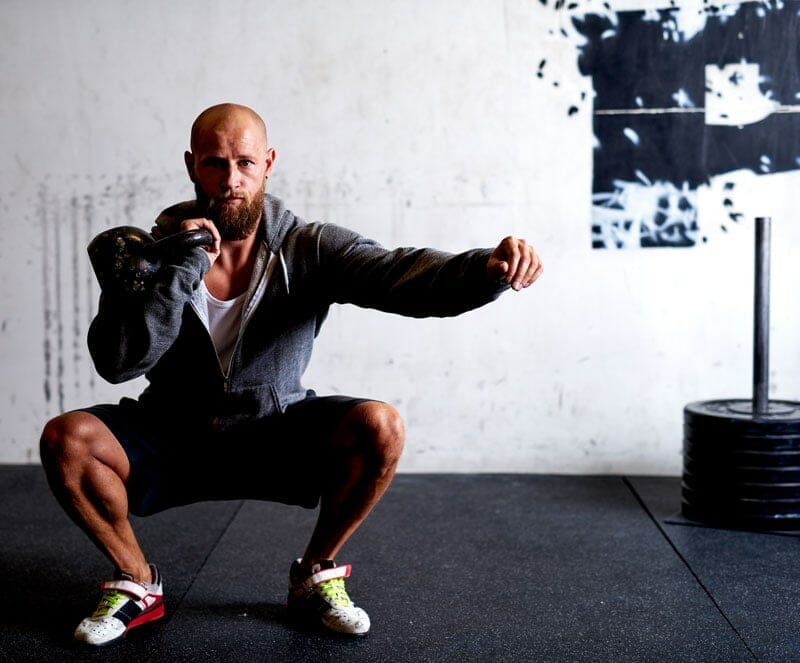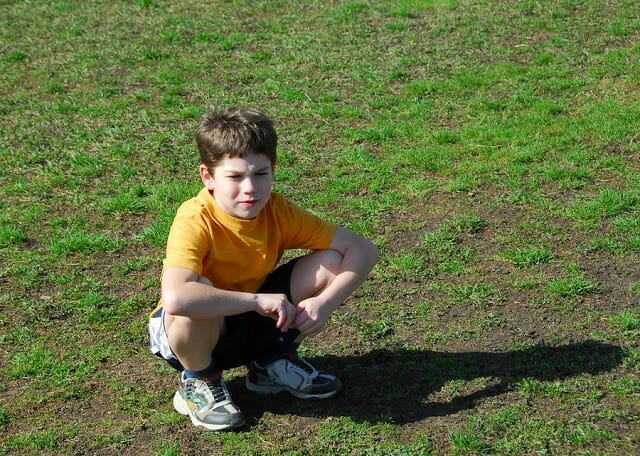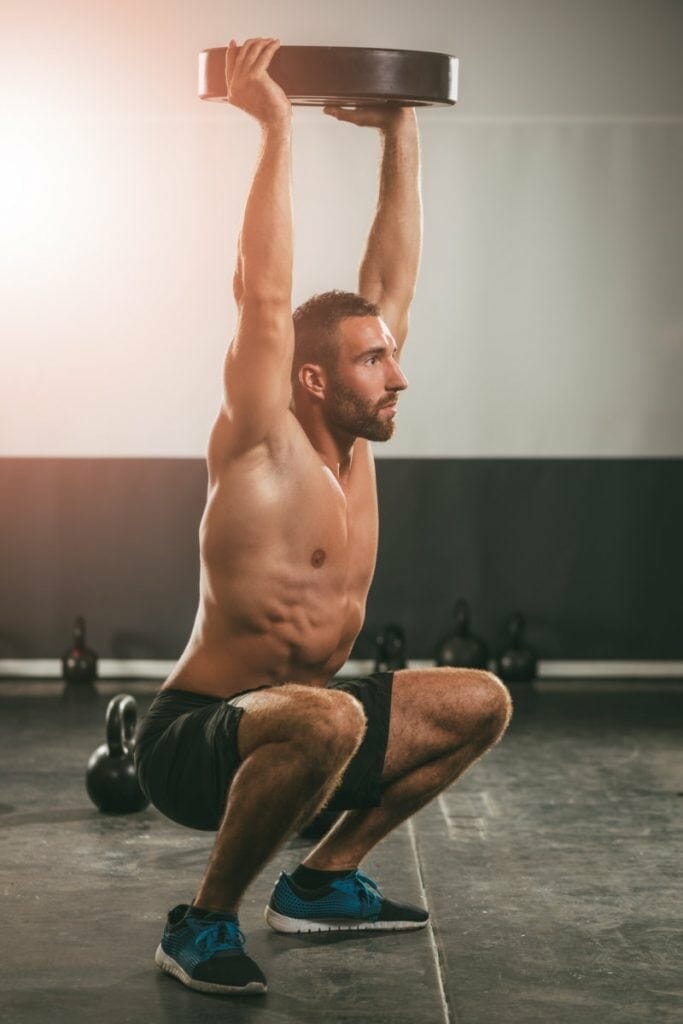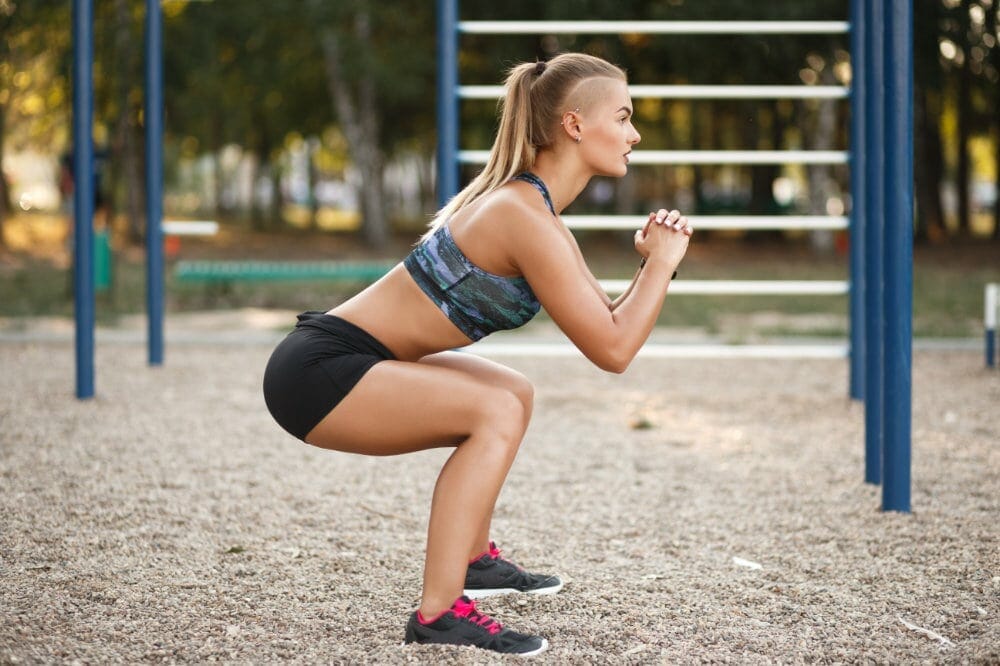“Take the load off your feet, have a seat!”. This helpful advice suggests to us that the act of sitting down will alleviate the stress on our feet caused by standing or walking for long periods. Correct, it will take the load off our feet but what happens to the load. Sitting does actually take the load off our feet. But just as energy cannot be created or destroyed, only turned into something else, the load on your feet must be transferred somewhere else once we sit down.
Where does the burden of gravity go? It moves from our legs to our spine, making our spine bear a load. And as anyone with back trouble knows, the spine hates to work harder than it needs to. Let’s look at why the squat is good for us and how to perform proper squats without weights.
Let’s just address this right from the beginning: squatting without weights isn’t going to build strength like loaded squatting. If it is at all possible, you should try and use weight when squatting because you’re going to get better results.
However, there are times where you may want to squat when you don’t have any weights to hand, and that’s where this can come in handy. The following provides some helpful information on how you should properly squat if you don’t have any weights.
Additionally, it discusses some of the basics of squats., the benefits of squats, and why you should practice squatting every day. If you want to learn how to squat properly with or without weights, move, jump, and lift weights with correct form and posture, try CrossFit.
Air squats and bodyweight squats are also excellent exercises for improving running speed.

Sitting is bad, Squatting is good
Sitting is not good for us. Being seated is not an optimal posture for our bodies and although the phrase ‘take the load off’ refers to relieving of pressure on the feet when seated, it certainly doesn’t apply our spine.
There three main positions that we find our bodies in every day: sitting, standing, and lying down.
Each of these positions puts a different amount of pressure on the back. When lying down the pressure on the spine is less than when standing and much less than when seated.
Sitting and leaning forward simultaneously puts huge demands on the spine and the difference between this position and standing or even sitting properly should make unsettling reading for those that regularly adopt this posture at work.
How to squat properly

In some non-western cultures that are unaccustomed to wearing shoes the people are almost completely free of the foot problems that plague western high-heel and boot-wearing cultures. Shoes are a necessity in our modern age but they have created as many problems as they have prevented.
As the very act of sitting for long periods of time at work is a modern first-world affliction we should take a look at certain other cultures and compare their ‘non-sitting’ lifestyles to ours to see if they have healthier spines. What do they do differently? They squat and they employ what we would call proper squat form.
Squatting, the act of sitting down supported by your own body, is a common daily feature of life in Asian countries. It’s unheard of in Western societies. If you’ve ever seen pictures of street sellers by the roadside and people that have been queuing for long periods you’ll notice that they are usually squatting rather than sitting.
Squatting is quite a natural position for people from this region (this is changing but still holds through for a large part of the population), and it’s a comfortable one. For most westerners squatting is very difficult and uncomfortable. Research has found that people of certain cultures have bone structures in their legs which support squatting but this is a result of their actions rather than a genetic trait.
How To do Squats Without Weights
In order to properly squat using just your body weight and no additional weight, follow these steps below.
- Make sure you’re standing with your feet just a little bit wider than shoulder-width apart from one another and make sure your hips are over your knees and your knees over your ankles.
- Make sure you roll your shoulders back and away from your ears. No matter what you do, try and make sure that you do not round your back (similar to a turtle shell) because this causes completely unnecessary stress on your lower back.
- Extend your arms straight out from your body in a manner that makes them parallel from the ground with your palms facing down. If you happen to find that it is uncomfortable for you to do it that way, then you can try pulling your elbows close to your body and face your palms towards each other while your thumbs point up.
- Start by inhaling with a deep breath and unlock your hips by bringing them slightly back. Continue to bring your hips back at the same time as your knees begin to bend.
- Once your butt is starting to stick out a little bit, make sure that you keep both your chest and your shoulders completely upright while also keeping your back straight throughout the process. Keep your head facing forward to keep your spine neutralized.
- In order to get the best results from your squats, make sure you are squatting as deep as your flexibility and mobility will allow you. The optimal way to squat would be to go far enough so that your hips are sinking below the knees, but that might not be possible depending on your flexibility. Try and push yourself to go down as far as your flexibility will allow you.
- Once you’re down, it’s time to get back up so make sure you use your entire core and place your body’s weight on your heels and shoot back up to a standing position, with most of the force coming from your heels.

In the squat position as opposed to the seated position the pressure on the spine is reduced (to note: the squat position is a far healthier way to position yourself for toilet functions – modern toilets don’t give us the option) and it’s worth putting your body in the squat position regularly to benefit your back.
Try this stretch and squat movement every day:
- From a standing position sit back slowly as if there was a chair behind you. Put your hands out in front for balance
- Continue sitting down (squatting) and try to go past the position where your upper legs are horizontal. This is difficult but a little stretching every day will help.
- As your butt begins to reach the floor your arms will naturally rest on your knees. Keep your head up and facing forward. The soles of your feet should remain in contact with the floor. Feel the stretch in your low back.
- Hold for 20 seconds and return slowly to standing position by pushing through the heels and engaging the abdominals to push yourself up.
- Repeat, increasing the time in the full squat and the number of repetitions as you become better at this technique.
Benefits Of Squatting
As you probably already know, there are many benefits from doing squats. Squats can help improve the circulation throughout your body because it gets the blood pumping throughout the entire body. The better circulation you have, the more nutrients and oxygen will be getting to your muscles and organs which will help improve the look of your skin and you’ll feel better.
Perhaps the biggest benefit of squatting that most people don’t realize is the fact that it can greatly help build muscles throughout your entire body. Squatting is an intense exercise and it helps release hormones that will help improve your upper and lower body. Additionally, there are a lot of exercises that put a lot of strain on your body, but squats are a low impact exercise, so it’s not going to bother those with back problems or weakened knees and ankles.

Squatting Is A Natural Movement
One of the biggest reasons that you should probably be considering squatting as part of your routine is because it’s a natural, human movement that most of us make just about every single day without even realizing it, or at least we should be. Every time you sit on a chair and then stand back up, you are essentially squatting.
Squatting is a motion you are familiar with making from an early age. A lot of stretches and exercises require you to do things that you aren’t used to doing, which can cause unnecessary stress and harm to your body. However, since you pretty much do some form of squatting just about every single day, your body is used to the motion and will not be sore or have prolonged pain after you squat.

How To Stretch Your Lower And Upper Body For Squats
As you should already know, the key to not injuring yourself during any type of exercise or workout is to stretch before you begin, and squats are no different. With squats, you want to make sure you stretch out both your upper and lower body because it will utilize all different areas of your body. However, the three main parts of your body to stretch out before you do squats are your ankles, knees, and hips, as those parts will do the majority of the work when it comes to squats.
If you try to do squats with tight ankles, you will not be able to squat as deep as you want, which means you will limit the overall success of your squat. Make sure you stretch out your ankles before squatting. Using a resistance band on your ankles can be a great way to do so.
Once again, the knees are important on a squat because you can only go as deep as your knees let you. Not only does this put you at risk for injury, but it can throw off the squat altogether. Try and do some lunges or a similar exercise before squatting to make sure you’re stretched out.
Lastly, try and stretch out your hips to make sure that you don’t round your back during a squat. Tight hips can put your spine at risk for an injury of any sort.
